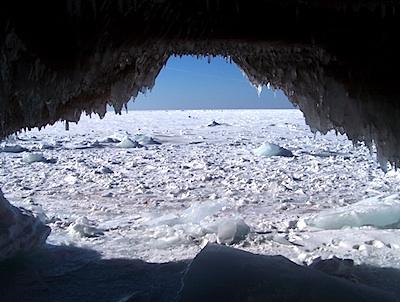While kayaking is a huge pastime at Apostle Islands National Lakeshore in summer, come winter one of the big attractions at the Wisconsin park are exploring its "ice caves."
Time, the waves of Lake Superior, and the usual freeze-thaw cycles of winter carved sea caves and shafts into the sandstone shores of Apostle Islands. "Delicate arches, vaulted chambers, and hidden passageways honeycomb cliffs on the north shore of Devils Island, Swallow Point on Sand Island, and northeast of Cornucopia on the mainland," note park interpreters.
And come winter, when the weather turns extremely cold, the lake waters freeze over, enabling visitors to explore the caves, which shoulder their winter nickname.
In February, the lake near the mainland sea caves is often a frozen white expanse. Lakeshore cliffs form a crimson border to this arctic landscape. Pillars of ice extend to the cliff tops where waterfalls have hardened in place. Frozen lakewater encrusts the base of the cliffs. Inside the caves is a fairyland of needle-like icicles. The formations change from chamber to chamber and from day to day.
This past week Apostle Islands officials thought they could safely open the ice caves to visitors to explore. Remote camera shots taken on Wednesday, February 6, showed a solid sheet of ice on the lake in front of the caves, a sheet roughly a foot in thickness.
But on Thursday, when park officials were laying the groundwork for opening the caves to the public, another picture came to light. But this one depicted not a solid sheet of ice, but rather a fractured sheet with bergs bobbing on the lake's surface.
"It had been stable and locked in to the nearest island for about two weeks," Superintendent Bob Krumenaker said Friday. “We were poised first thing Thursday morning to gear up for major visitor activity this weekend.”
Instead, word went around that the ice had broken up and it would take another extended cold spell to refreeze the lake and possibly allow the caves to be opened to the public.
“Because its been a colder winter than we’ve had in several years, people were really very excited and expectant. It's a big deal in this community and for the people who do this kind of recreation," said Superintendent Krumenaker, noting that in the past there have been days when hundreds of people were out on the ice exploring the caves.
“It just shows you how fragile this stuff is. It’s an incredible reminder to people here that you cannot trust the ice on Lake Superior,” he said.




Add comment